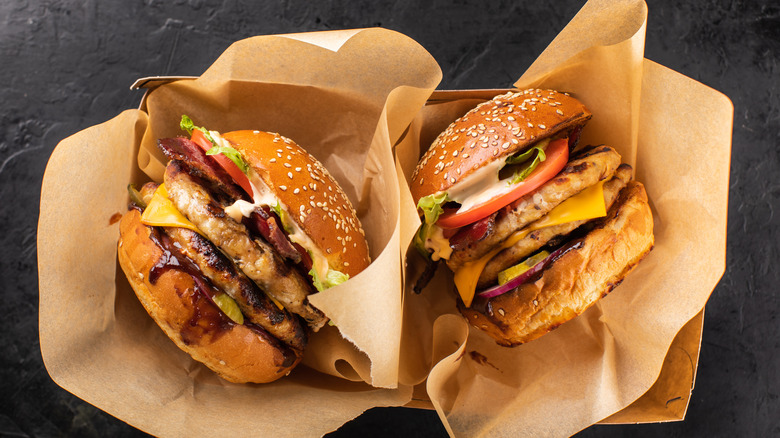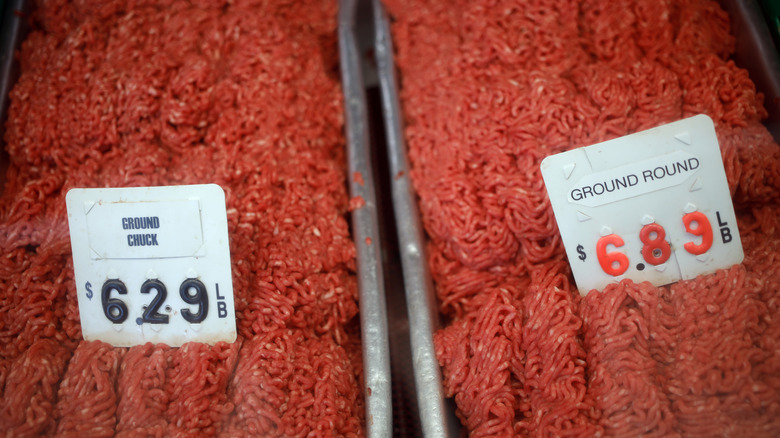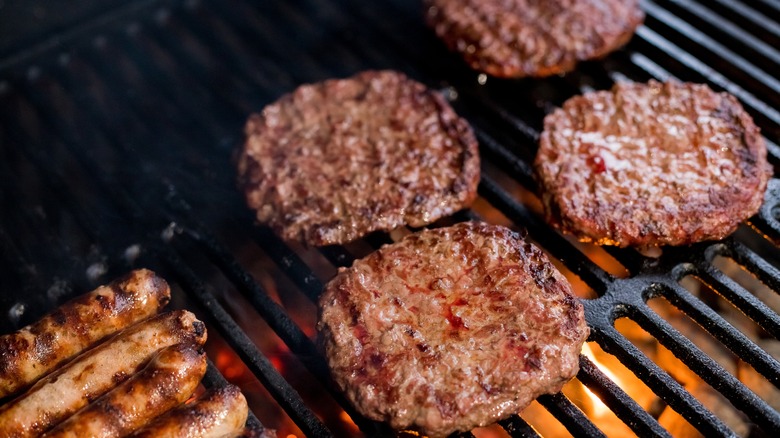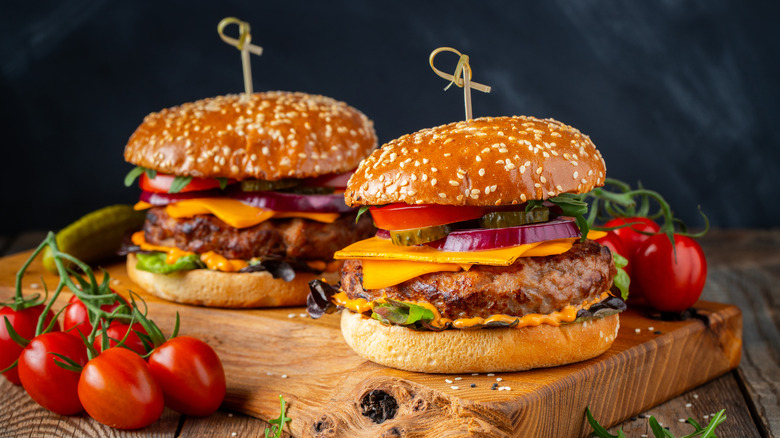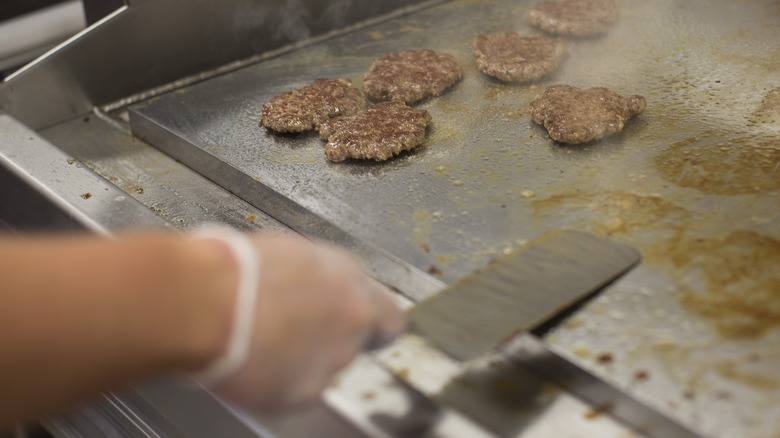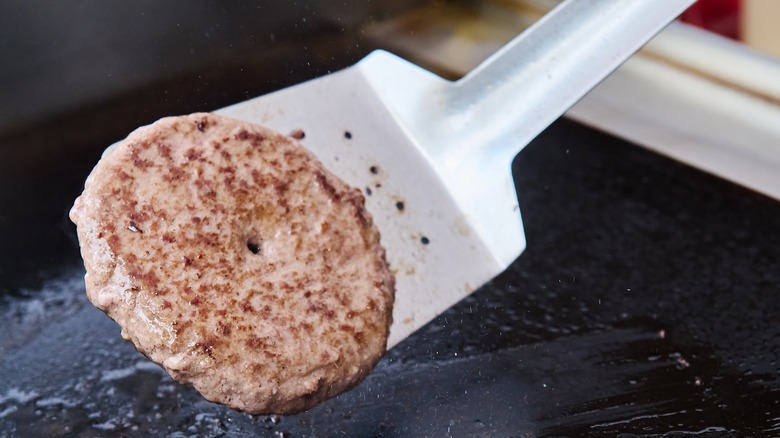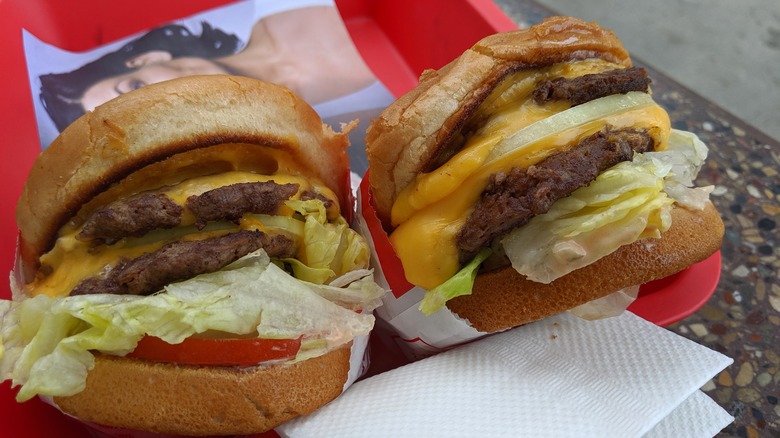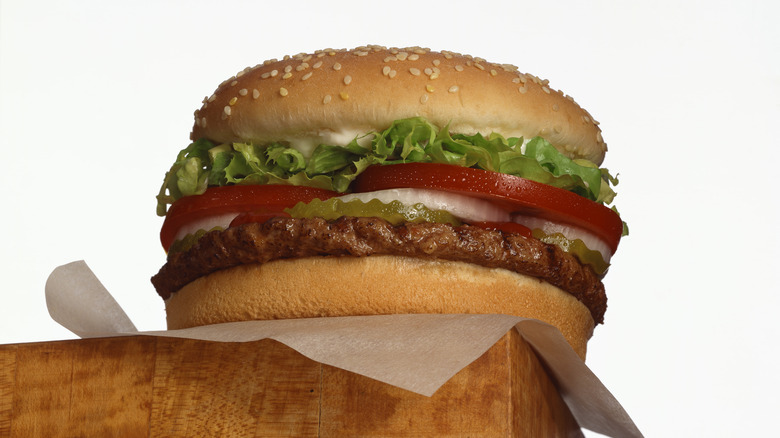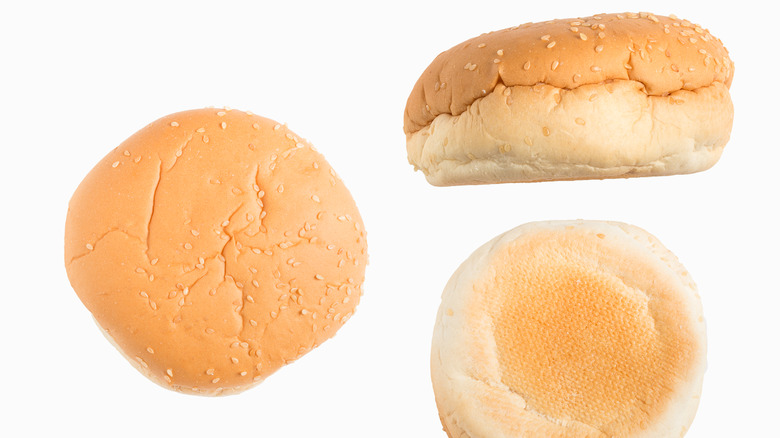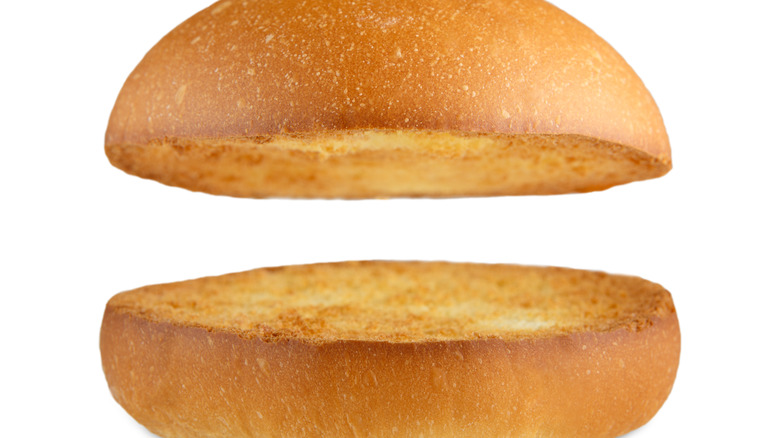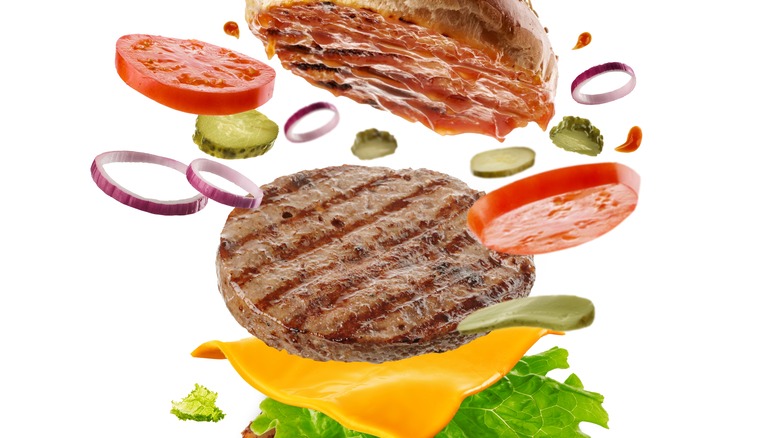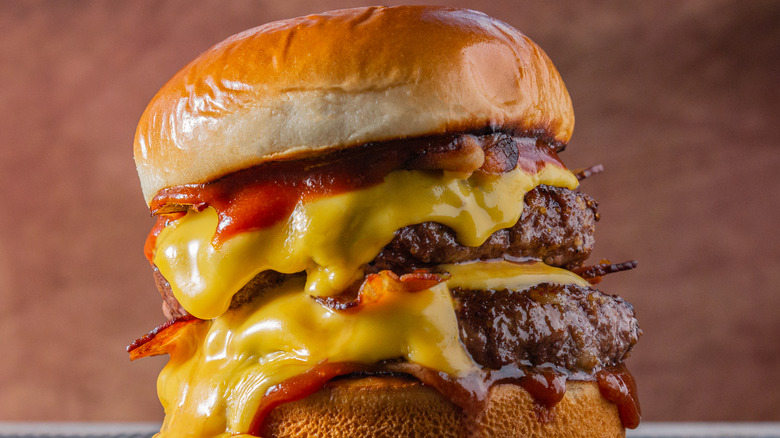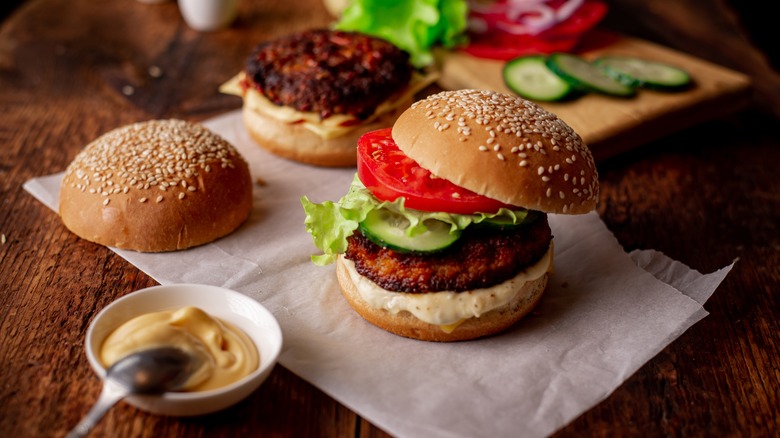Why Burgers Always Taste Better At A Restaurant
Ah, burgers! Diners crave them, and other foods — from black beans to portabella mushrooms to ground turkey and Beyond Meat patties — long to be like them. And it's no wonder: American diners are deeply devoted to their burgers — so much so that the average American eats 60 burgers a year, or over one a week, per SWNS Digital. This devotion is more than just dietary: For Americans, burgers aren't just fuel, but also an important cultural touchpoint. In a 2022 survey conducted for White Castle, a third of respondents said that a good burger reminds them of happy times with family and friends, according to SWNS Digital.
And while burgers are simple to make, diners overwhelmingly prefer to outsource their burger production: According to the South Florida Reporter, 73% of the burgers consumed in the U.S. were made and purchased outside the home. Part of this could be because it's simply easier to zip through your favorite drive thru for a burger fix — no additional shopping, prep, or cleanup needed. But if we're being honest, takeout and restaurant burgers are just more satisfying: If you've noticed that your homemade burgers are missing that special something, it's not just you. Here's what the pros do differently.
Restaurants choose the right fat content for their burgers
At the heart of every great burger is the right meat. And when shopping for ingredients for their homemade burgers, well-intentioned home cooks seek out what they think is the best-quality ground meat and often reach for the option with the lowest fat content. After all, you want to taste beef, not fat, so shouldn't the leanest meat give you the beefiest flavor?
Sadly, no. According to The New York Times, the beefiest, juiciest burgers are made from meat with a fat content of about 20%, and restaurants typically source meat with this fat ratio. Anything leaner than that will cook up dry and flavorless — so avoid choosing any ground beef specifically marked "lean." If you're craving the juiciness and flavor of a traditional burger, you'll have to accept that it won't be diet food and enjoy it without apology. Still, it's possible to have too much of a good thing — and star chef Michael Symon told The New York Times that overly fatty meat can also yield a substandard burger. "Things happen," he told The New York Times. "Bad things. Shrinkage."
The right patty size matters
Enjoying a burger is about more than just taste — it's also a visual and tactile experience. There's something satisfying about the look and feel of a good restaurant burger in your hand, the patty perfectly encased between the buns without being overwhelmed by them. This is because restaurants size their burgers consistently — look at the flattop behind the counter at any fast food place, and you'll see row after row of identically sized patties. In contrast, our measured-by-eyeball homemade burgers often come out too big or too small for the bun.
So what size should your burger patty be? This depends on the type of burger you're shooting for. Generally, per the Chicago Tribune, burgers fall into two families –- thick, pub-style burgers and the thin, crispy-edged smash burgers found at most fast food places and diners. Both can be delicious, but to get them right, the patties have to be appropriately sized. A good size for a smash burger is 3 to 4 ounces of raw meat (about the size of an ice cream scoop, according to The New York Times). For a pub burger, around 7 or 8 ounces of raw meat is appropriate. But avoid the temptation to go much bigger than that. "You want to get some heat to the inside of the burger," Geoffrey Zakarian, chef and owner of the National Bar and Dining Rooms in Manhattan explained to The New York Times. "You don't want some giant, underdone meatloaf."
This pro tip will help you avoid bulging patties
In burger making, as in life, getting the simplest things right is sometimes not as obvious as it seems. Take the seemingly mindless task of shaping a hamburger patty: Grab a handful of meat, roll it into a ball, and flatten it to your desired thickness. Provided you portion out the right amount of meat and your patty is reasonably round, you should in principle end up with a perfectly cooked burger, ready to slide onto a bun and top with the condiments of your choice.
But as many of us have learned from personal experience, uncooked burgers can undergo ugly transformations during cooking. Instead of cooking up as perfectly flat disks, they can evolve into bulging blobs resembling lopsided meatballs — something that never seems to happen at restaurants. According to Cook's Illustrated, the bulging occurs because the meat's connective tissue contracts under high heat while the meat itself swells, causing the patty to bulge. This is more likely to occur when cooking with a grill or broiler, where the edges of the burger are exposed to high heat and likely to contract. To counteract this, celebrity chef Bobby Flay recommends pressing a thumbprint into the center of each patty, which "fakes out the burger" by making the center thinner than the edges (per Today).
Flat-top griddles or pans give restaurant burgers a beefier flavor
There's a reason burgers from fast food joints and greasy spoon diners have that distinct succulence that's tough to replicate at home. Look closely at how they're made — almost always, it will be on a hot flat-top griddle that has seen dozens, if not hundreds, of other burgers cooked on it that day. All these burgers leave behind fat and flavor to be absorbed by the next batch of burgers.
This is why George Motz, the filmmaker behind the documentary "Hamburger America," advises home chefs to cook their hamburgers in a skillet, never directly on a grill. The rendering fat that collects in the pan, he told The New York Times, bastes the meat and contributes extra flavor. "Grease is a condiment that is as natural as the beef itself," Motz told The New York Times. "A great burger should be like a baked potato, or sashimi. It should taste completely of itself." If you really want to use your grill (for instance, if you have it already heated up for other foods), Motz advises heating your skillet on the grill to cook your burgers.
Burger pros know when to flip a burger – and when to wait
Passionate home cooks are hands-on people who love working with (and playing with) their food. But while a willingness to watch cooking projects closely and make any needed adjustments is laudable, there is also virtue in knowing when to stand back and do nothing.
Take the case of flipping burgers. Contrary to what your parents might have told you, flipping burgers on a professional level actually requires some skill. While some well-meaning home cooks flip their burgers compulsively, either out of a fear of burning them or the need to feel like they're doing something, pros know that giving their burgers a period of contact time with the griddle yields the tastiest results. As celebrity chef Bobby Flay explained to Today, you should leave your burger undisturbed in your pan or griddle for at least three minutes so it develops a flavorful crust. "Do not even start flipping the burger until a crust has formed or the meat will fall apart, and you will lose that perfect round shape," Flay told Today. Thus, he said, your burger should only be flipped once.
Restaurant cooks avoid smashing burgers when cooking them
In busy professional kitchens, a common mantra is "work smarter, not harder." Experienced cooks know how to make every movement count and understand that sometimes doing less can not only save them time and effort, but also yield better results. And this holds true even for the seemingly simple task of cooking burgers. If you've ever been to a busy diner or take-out and seen a cook frying up dozens of burgers at a time, you might have noticed the cook didn't move them around or repeatedly smash them the way some nervous home cooks do. Instead, pro cooks mostly monitor them for doneness, flipping them just once before serving them.
While this clearly has practical advantages -– repeatedly smashing a dozen or more burgers at the same time is time-consuming and tedious –- it also has a culinary advantage. As noted by the Chicago Tribune, un-smashed burgers are juicier and tastier. This makes sense: When you press down on a burger, you're squeezing out flavorful juices. So even if you're making thin smash burgers, smash them down only once at the beginning of the cooking process –- and avoid the temptation to do it again.
Restaurant burgers can have a better texture than homemade for a surprising reason
One of the things that makes the best restaurant burgers so succulent is the texture of the meat –- firm enough to hold together, but still tender and juicy. If you've had trouble replicating this texture at home and have found yourself with dense, rubbery burgers instead, a few simple pro tips can put you closer to burger perfection. And you'll be happy to know these tips will not only make your burgers taste better, but save you some time.
First, according to Cook's Illustrated, don't bother mixing seasonings into your meat before shaping it into patties. Salt dissolves protein, so if mixed in before cooking, it will start to compromise the texture of your burgers before you even get started — this is one of the common causes of burgers with a dense, sausage-like texture. Instead, per the Chicago Tribune, you should generously season your burgers only on the outside after forming the patties. Second, the Chicago Tribune warns against overworking the meat, which can toughen it. Instead handle it as gently as possible to form patties that just hold together.
Restaurants are choosy about the hamburger buns they use
We all know what it's like to put together your own burger at a backyard cookout -– you grab a just-cooked burger off the serving platter, pull a cold bun from a plastic bag, and put it together with whatever condiments the host has around. And while the company and conversation may be great, the burger itself will likely be mediocre -– even if the cook got the burger right, it will be saddled inside a mushy, flavorless bun that's probably too big or too small for the patty.
There's a reason hamburger buns at your favorite fast food place taste better than those you pick up at the supermarket: As reported by Baking Business, restaurants commission their own buns sized and formulated for their specific requirements. Baking Business notes that quality hamburger buns must meet a number of standards: Among other things, they must be soft and fluffy enough to be easy to chew, but resilient enough not to get soggy under the weight of meat juices and condiments. They must also bake to a uniform color (restaurant chains specify their color standards for acceptable doneness). If you don't have the clout to commission your own bespoke buns, Michael McDearman, a judge for the World Burger Championship, recommends Martin's potato rolls, according to the Chicago Tribune.
Restaurants toast their buns for better flavor and texture
Burgers might have a reputation as brainless fast food, but restaurant chains put a lot of thought into the details of their production, from the size of the patties to the color of the buns (per Baking Business) to the choice and amount of toppings. And one simple detail sets restaurant burgers apart from many of their homemade counterparts: A toasted bun.
This extra step really does make a difference, as McDonald's found out the hard way, according to Fortune. In the 1990s, McDonald's decided to stop toasting its buns in an effort to streamline operations, only to backtrack a few years later after customers protested the change. Since then, it's doubled down on toasting its buns: As part of the chain's 2018 strategic turnaround plan, it ordered its restaurants to toast buns five seconds longer, keeping burgers warmer longer. And according to Eating Expired, toasting hamburger buns not only keeps burgers warmer, but it also improves their texture by keeping the buns from becoming soggy while you eat.
Layer burger toppings in the right order for restaurant-quality structure and texture
There's nothing more satisfying than that first bite of a fully loaded burger topped with creamy condiments, gooey melted cheese, and crisp and juicy vegetables. And there's nothing more frustrating than painstakingly assembling that perfect burger and taking a big bite only to have most of its contents slide out of the bun and onto your lap.
It doesn't have to be that way. Even generously topped knife-and-fork restaurant pub burgers tend to hold together because the toppings are layered strategically to prevent sogginess and slippage. Experts differ on what the optimal ordering of toppings should be, but The Art of Manliness offers a well-reasoned strategy you can use as a starting point: Spread your condiments (such as mustard and ketchup) on the top and bottom buns to help anchor the other ingredients in place. If you're using mayo, spread it on the bottom bun, where it will act as a barrier to prevent meat juices from making the bun soggy. Next, layer lettuce, then tomatoes on the bottom bun (they'll be less likely to slip out if placed under the meat, and the lettuce will also further protect the bun from sogginess). Then add your cooked patty with melted cheese, then onions and pickles if using, then the top bun.
Restaurants melt their cheese completely
There's a right way and a wrong way to add cheese to your burger. The wrong way — all too familiar at backyard and beach barbecues as well as camping trips — is to set out a pile of cheese slices straight from the cooler for diners to add after their burgers are cooked. It's dead easy, but based on one of two faulty premises: first, that cold, hard cheese is just as appetizing on a burger as melted cheese, or second, that residual heat from the burger will be sufficient to melt the cheese. News flash: It's not, and it won't.
Instead, as celebrity chef Bobby Flay tells Today, you need to be sure to melt your cheese completely — and don't skimp on the quantity of cheese. His go-to combo is a slice of American cheese (which he loves without apology) and a slice of white cheddar. He puts on the cheese just after flipping the burger, adds a splash of water, then covers the pan: The water steams, causing the cheese to melt evenly and fully. This step is critical for making burgers that meet his exacting standards. "In my restaurants, there is a sign in each kitchen that says: 'Bobby Says Melt the Cheese Completely,'" Flay told Today. "It has to be melted to have the perfect cheeseburger."
For a restaurant-level burger, don't forget the butter
If you've ever wondered why some restaurant burgers have that extra bit of richness and flavor that you've never managed to achieve with your homemade burgers, here's some good news: The missing piece to the puzzle is probably already in your refrigerator. Some popular hamburger restaurants, including Culver's and Smashburger, use butter when preparing their burgers, and it can make a big difference in the flavor and texture of the finished burger.
And happily, you don't need to drench your burgers in butter to make them noticeably richer. While butter is so central to flavor profile at Culver's that its signature dish is known as the Butterburger, in reality, Butterburgers only include a touch of butter, which is spread lightly on the top of the bun. (This innovation, according to Culver's founder Craig Culver, came from his mother, who always made her burgers at home this way.) Meanwhile, Smashburger uses butter on its griddles to fry its burgers — this adds not only extra flavor, but helps the burgers develop a toasty, caramelized crust and a touch of crunch.
